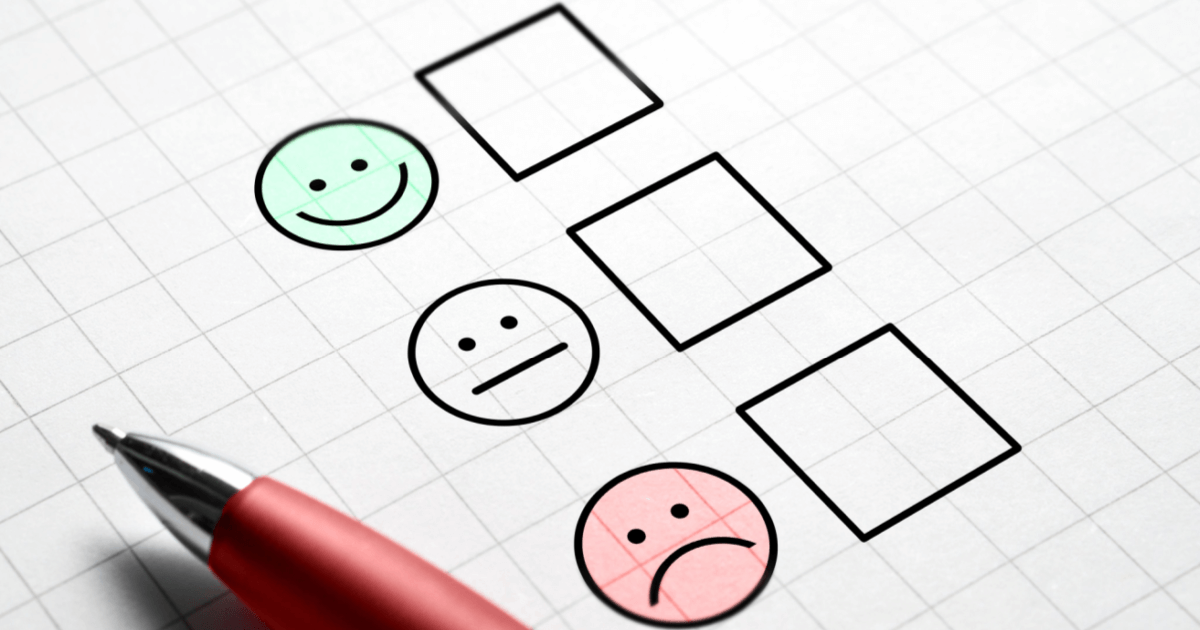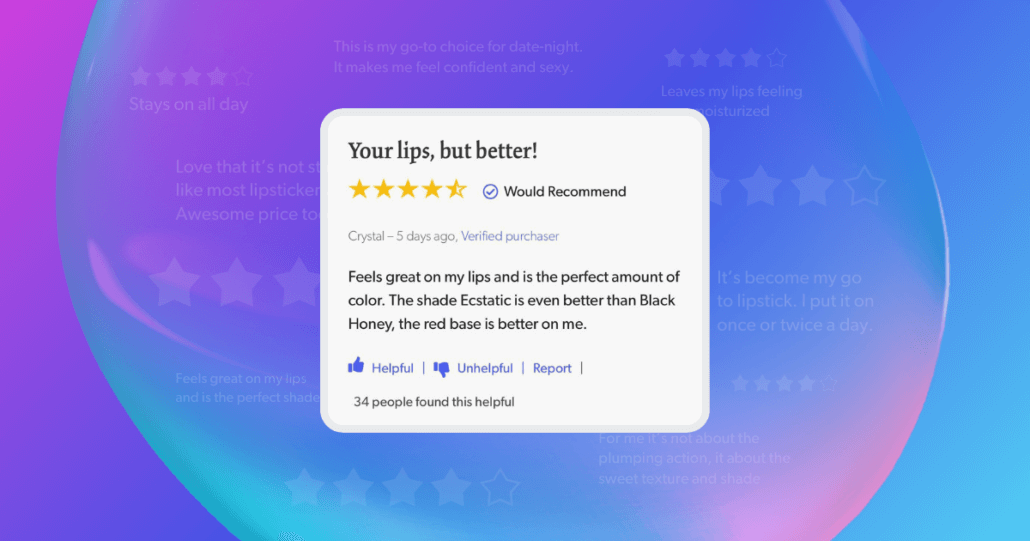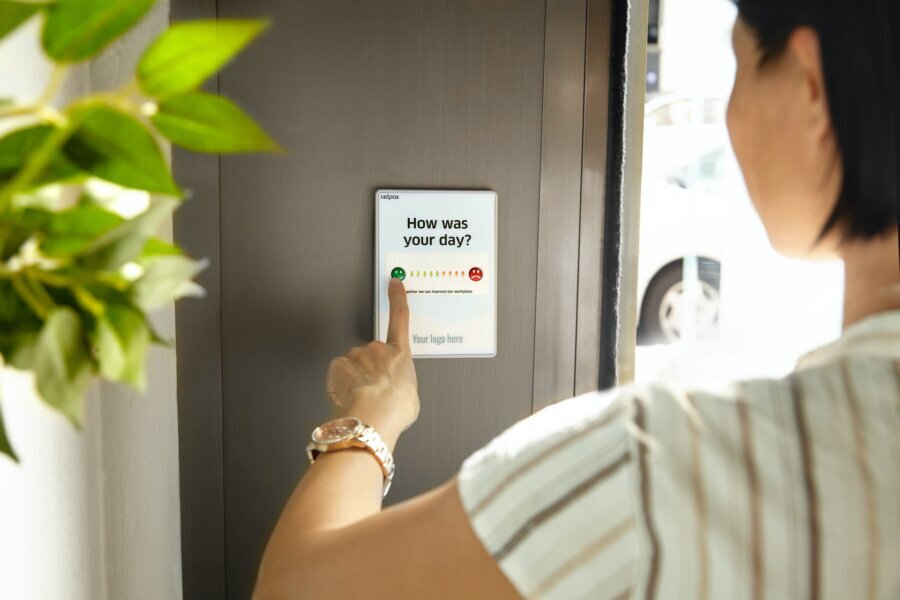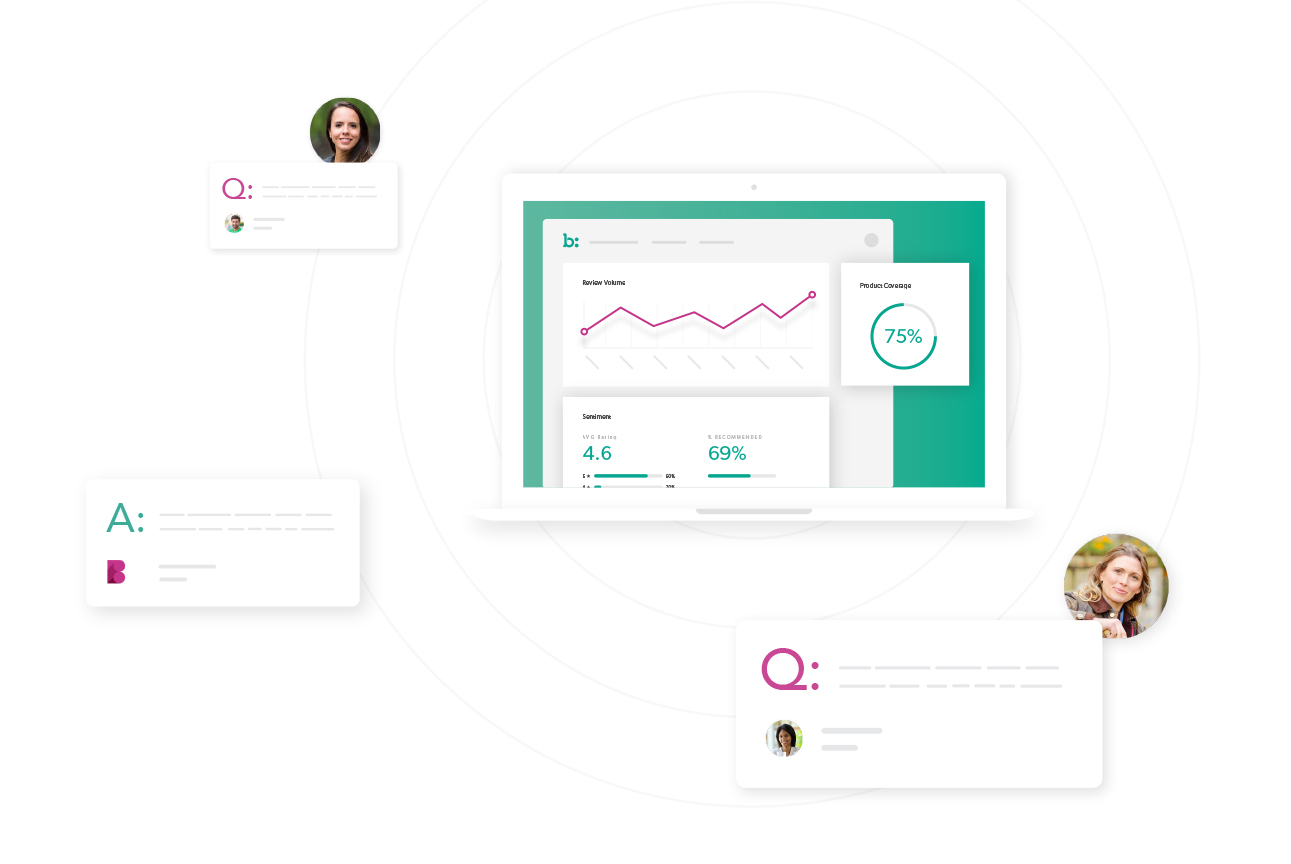June 22, 2022
In a perfect world, your customers’ needs, goals, and perceptions should shape every aspect of your marketing, product design, and customer outreach.
But let’s be real. The world is not perfect.
At first glance, collecting all of that data about your customers can seem like a daunting process. Actually leveraging it to boost sales can feel even more overwhelming.
But with properly designed customer satisfaction survey questions, you can collect powerful user data at multiple points in the buying process. These surveys can be embedded on your website, in emails, and on multiple other customer touchpoints, allowing you to streamline and automate the process of better understanding your customers.
As for actually putting all of the insights you gain to use, we’ll show you how to use the data you collect to make smarter business and marketing decisions. We’ll also share various customer satisfaction survey examples, as well as tips for boosting engagement.
What’s the purpose of customer satisfaction survey questions?
In a recent poll, 65% of customers said a positive experience with a company had more impact on their buying decisions than a great ad.
But another survey revealed that more than half of customers think brands are failing to meet their service and experience standards. In the UK, two-thirds of consumers can’t even remember the last time a brand exceeded their expectations.
The right customer satisfaction survey questions help you better understand what customers and consumers think about your overall brand, product/services, and customer service efforts.
They also help you collect valuable feedback and content that can be used to improve every aspect of your customer experience, from marketing to product development to your website and social media outreach.
What types of questions are in a customer satisfaction survey?
At a high level, survey questions are either:
- Open-ended. They allow the recipient to answer the prompt in his or her own words
- Closed-ended. The recipient is provided with a preselected set of answers to choose from
Here’s a few examples of open- and closed-ended question formats you can use in your outreach. For best results, consider experimenting with different question types on each form and testing to see which get the most engagement.
Don’t worry. We’ll talk more about testing your customer satisfaction survey questions in a bit.
Multiple-choice questions
Multiple-choice questions are closed-ended. They’re typically the most popular because they’re less work for the customer to answer. Which also means you’re more likely to get responses!
These can come in a variety of flavors, from scales to star ratings. These are a few of the most common multiple-choice question formats used in customer satisfaction surveys.
Likert scale
Likert scale questions allow you to measure how your customers feel about a specific aspect of their experiences. They’re typically used to understand how much your customers agree or disagree with specific prompts.
Example:
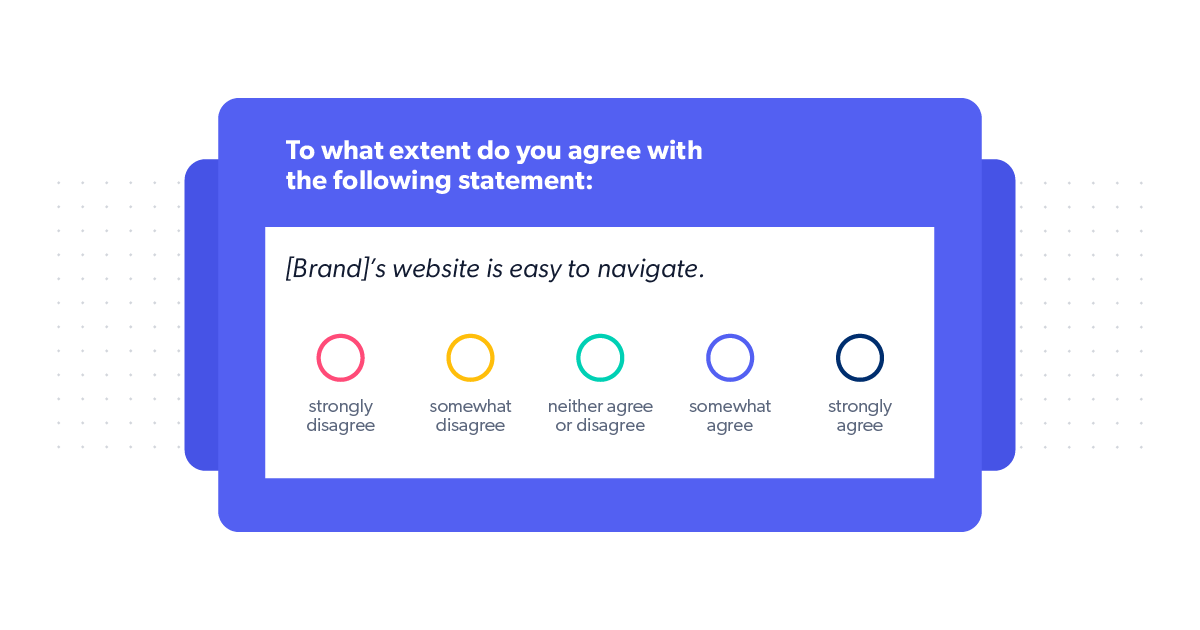
In addition to words and numbers, you can also use emojis, graphics, and other elements to measure your customers’ reactions.
Star ratings
Star ratings are similar to Likert scales. Customers answer each question by assigning a star value to their experience. We all know these. The more stars, the better their experience. Global brands like Amazon, UberEats, Asos all use this system.
Example:
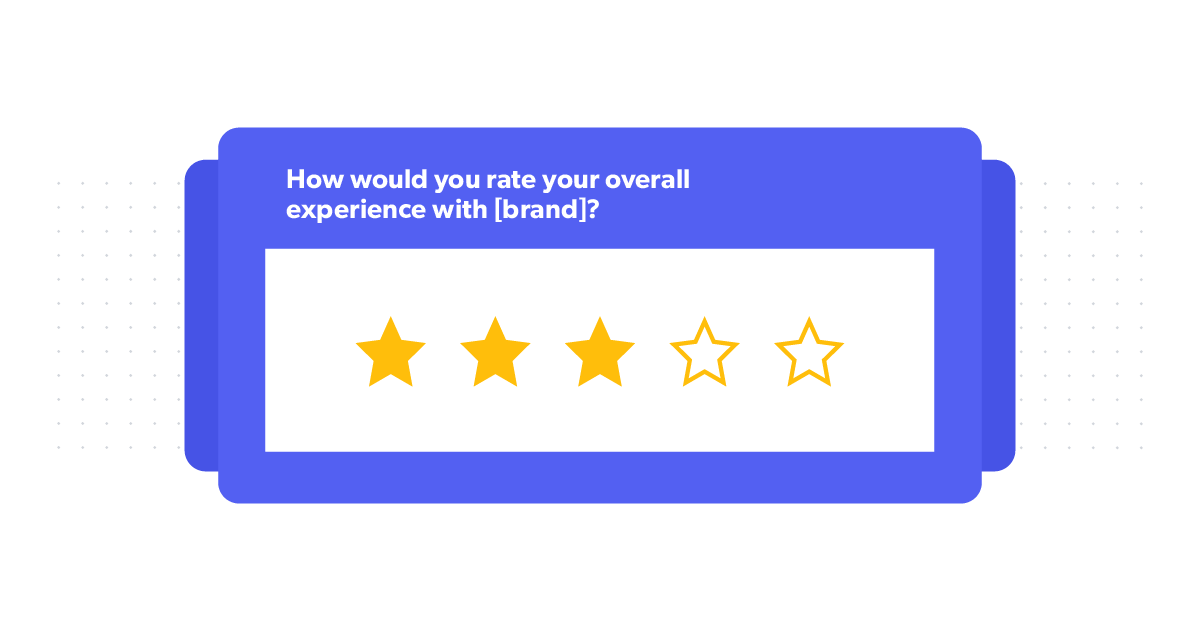
Binary scale questions
These offer a choice between two answers, such as yes/no or a thumbs up/thumbs down.
Example:
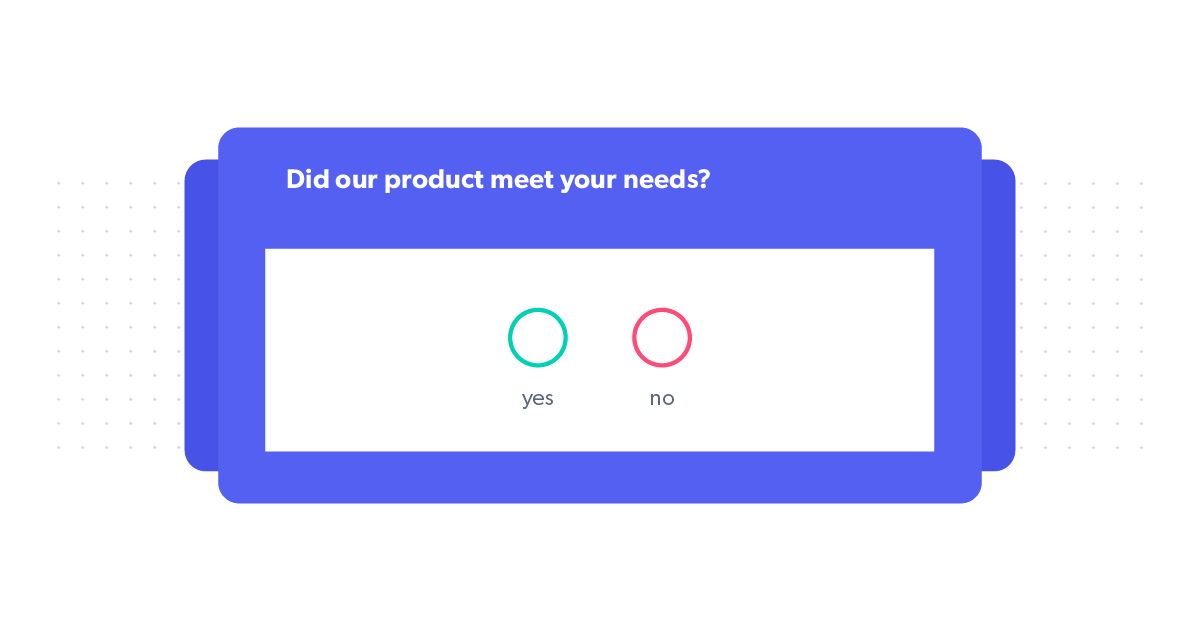
Semantic differential scales
These customer satisfaction survey questions typically feature two statements. Consumers can pick a point on a scale between the two that best describes their experience.
Example:

Open-ended questions
While you’re more likely to get a response to a closed-ended customer satisfaction survey question, they do have their limitations. Mainly, they don’t allow you to ask follow-up questions or understand why customers behaved or felt the way they did.
With open-ended questions, customers are given a text box and encouraged to answer the question in their own words. This allows you to capture the natural language they use to describe their challenges, needs, and perceptions.
Example:
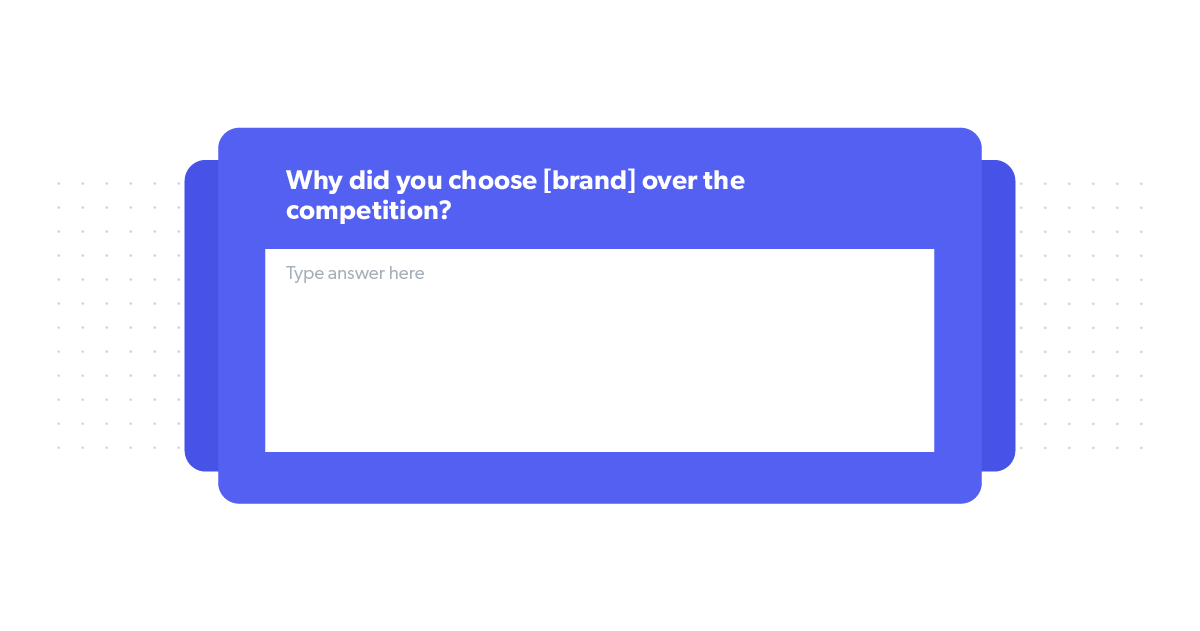
What to do with the results of your customer satisfaction survey questions
Customer satisfaction and product surveys can do one of three things.
- They can provide a wealth of actionable data that you can use to improve the shopper experience and explore new marketing and operational strategies.
- You can use them to collect valuable user-generated content. Which is something you should really be doing.
- They can collect digital dust sitting unread in your shared drive.
Here’s how to make sure you’re not just collecting data for the sake of collecting data.
Use the data to create reports
The easiest and fast way to leverage all of that amazing data is to turn it into powerful customer sentiment reports. You can also create a dashboard to track customers’ responses over time.
Identify trends and patterns
Go over those reports and dashboards regularly to find and understand repeat issues. Are customers continually complaining about one feature of a product? Do they wish for a wider selection of colors or patterns? Do they hate your checkout process?
Take action
Once you understand more about your customers and their needs, use the data to take action. Double down on what’s going right and work on fixing what’s going wrong.
You might also use customer responses as an excuse to explore creating new items or promoting new uses for existing products.
Respond as needed
Collecting customer insights, let alone turning them into action items, takes time. While you’re digesting and analyzing the data you collected, take a moment to acknowledge the people who responded to your survey.
Thank them for participating. If they had a complaint, let them know you’re looking into the issue. You can also invite them to stay in touch about their experiences via email or social media.
Consumers simply want to know that you’re listening. When someone feels connected to a brand, 76% said they’ll continue purchasing the company’s products and 57% said they will spend more.
Customer satisfaction and product survey questions to ask throughout the buying cycle
It’s not your customers’ responsibility to provide feedback about your products and/or services. Instead, it’s up to you to create surveys that people actually want to engage with.
Here are a few sample customer and product satisfaction survey questions to help you collect valuable information from your customers at multiple stages of the buying cycle.
Awareness
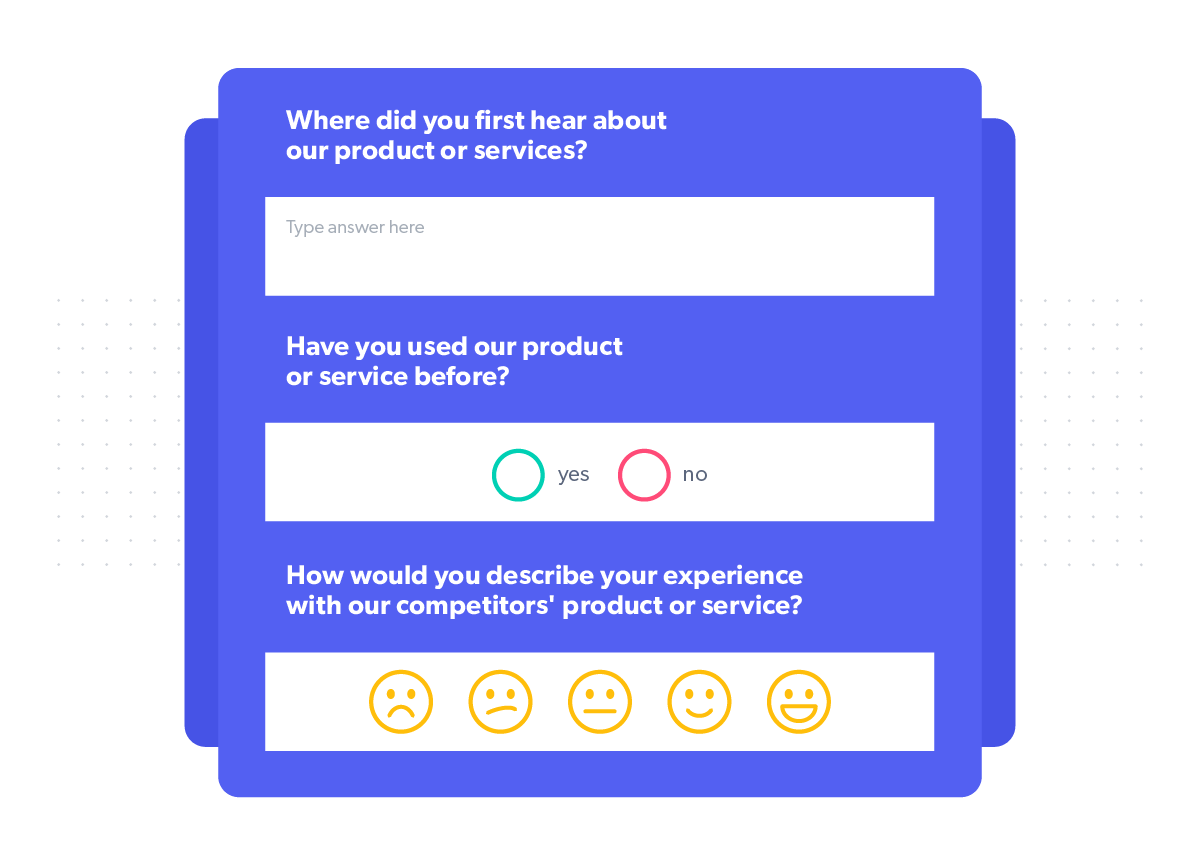
Consideration

Purchase
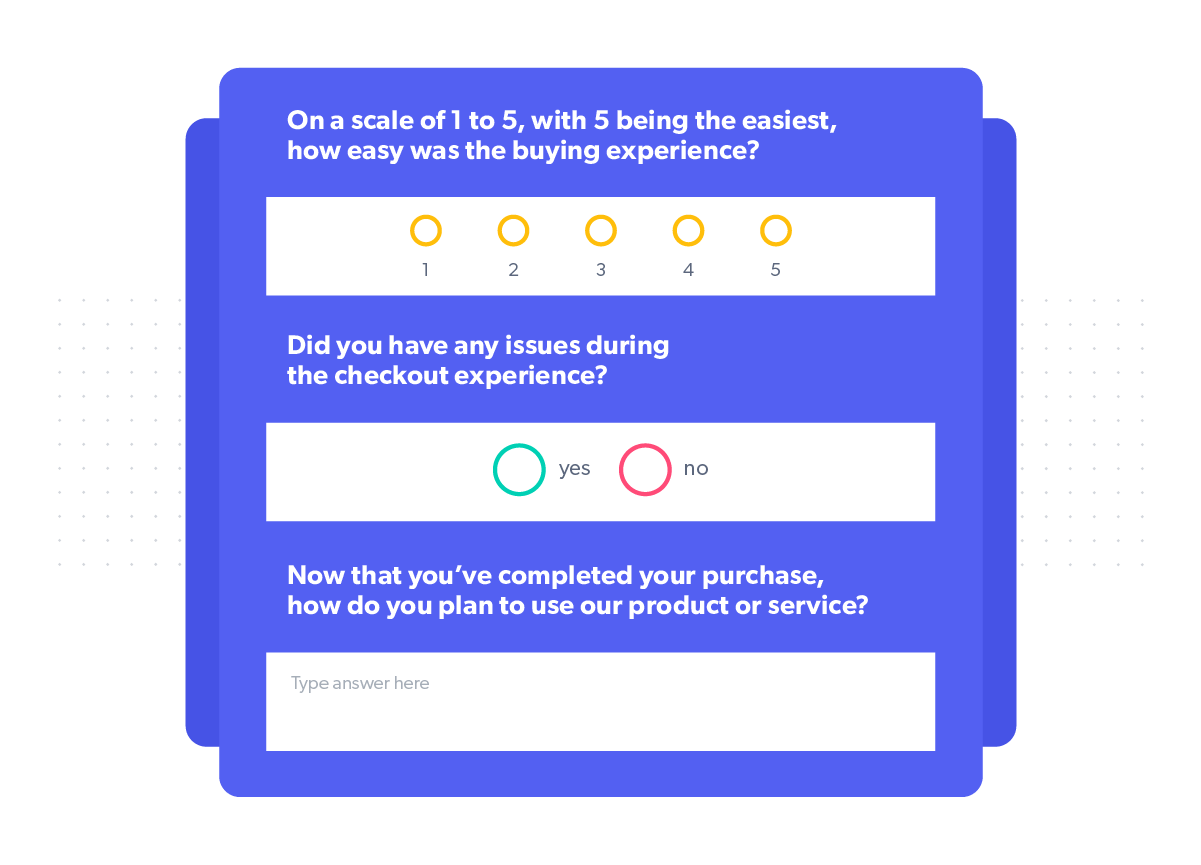
Onboarding

Use
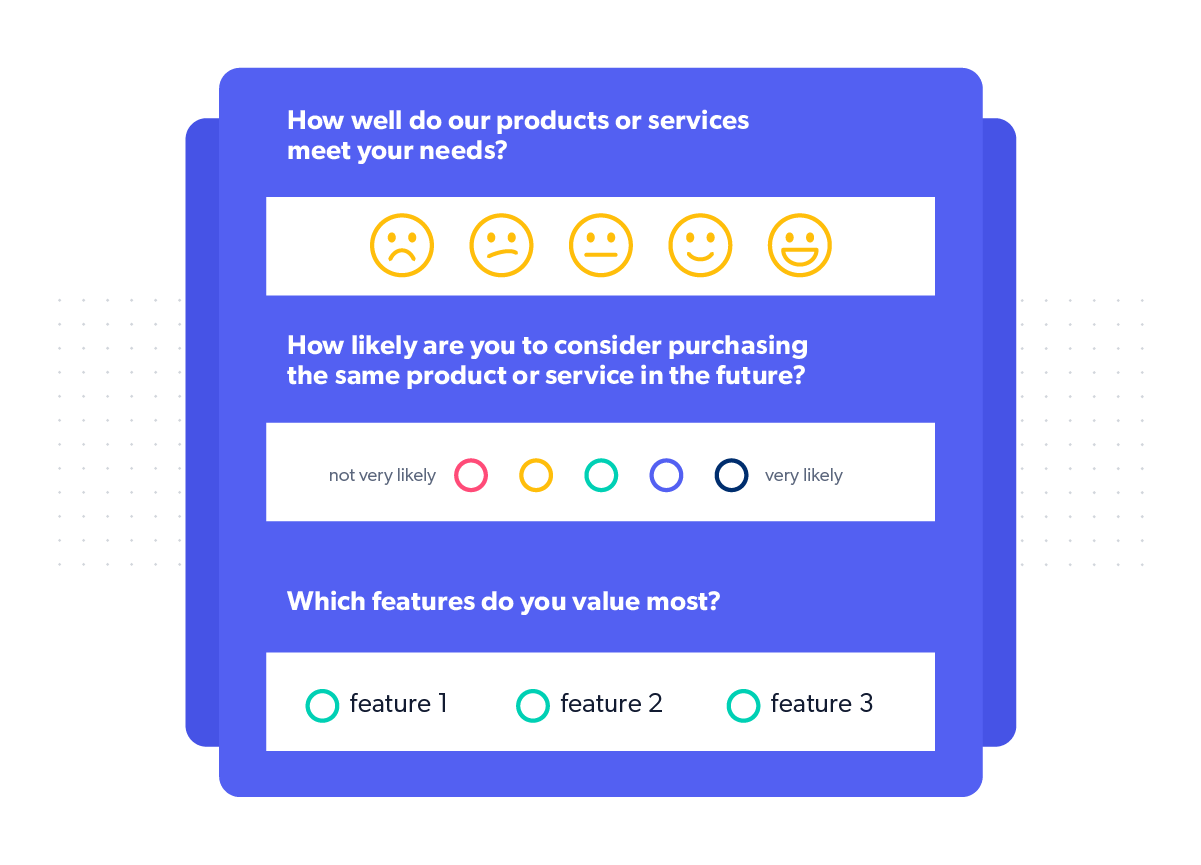
Loyalty
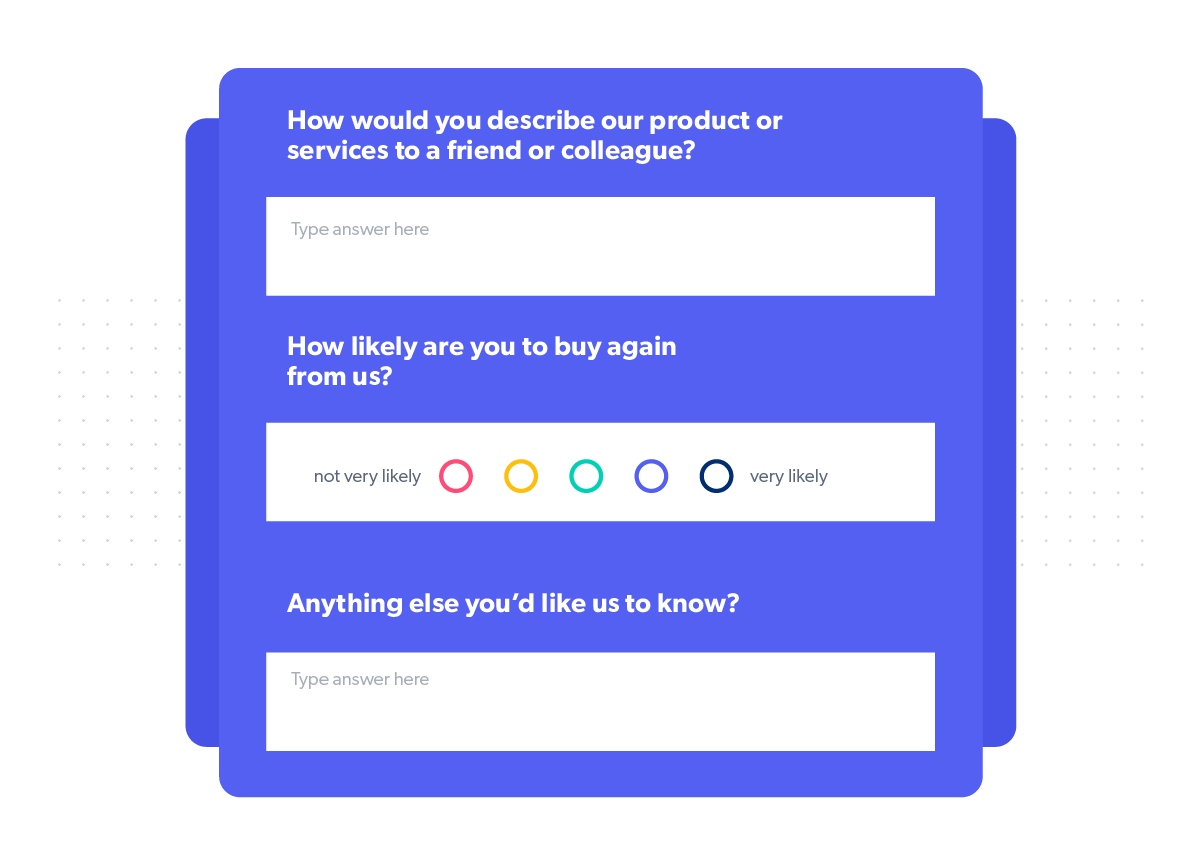
Additional types of customer satisfaction and product survey questions
Net Promoter Score (NPS®)
These ask your customer to rate how likely they are to recommend your product or service to a friend or colleague on a scale of 1 to 10.
Example:
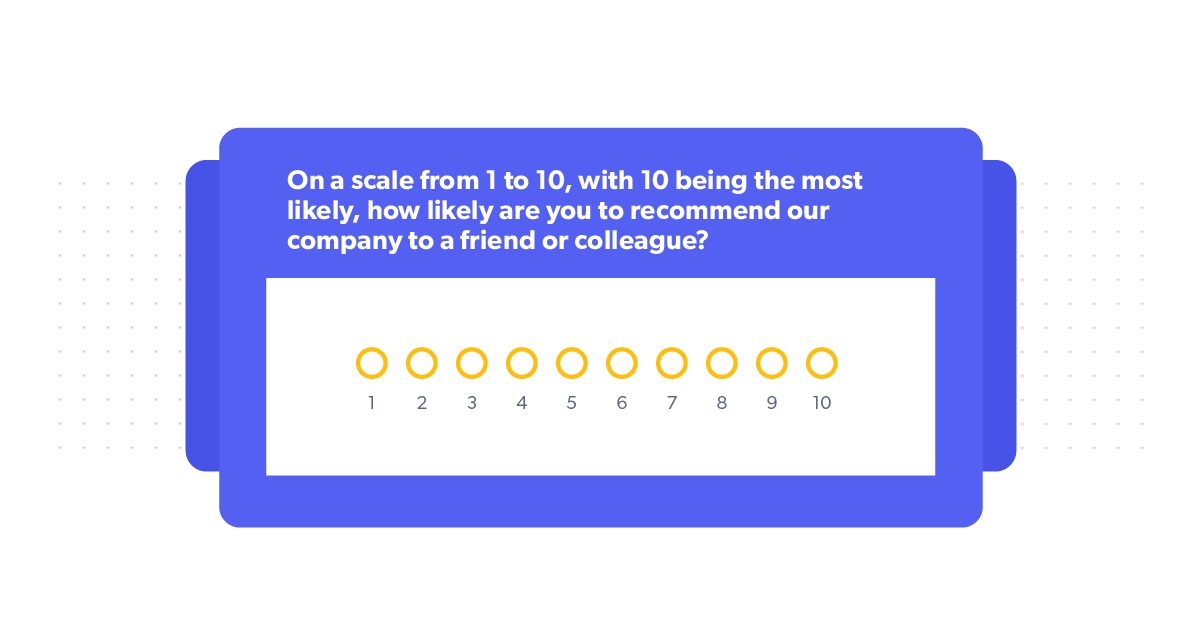
Customer Satisfaction Score (CSAT)
This question type is designed to measure a customer’s overall satisfaction.
Example:

Customer Effort Score (CES)
This is typically sent after someone engages with your customer support team. The form consists of one question along the lines of: “How easy was it to solve your problem?”
Example:
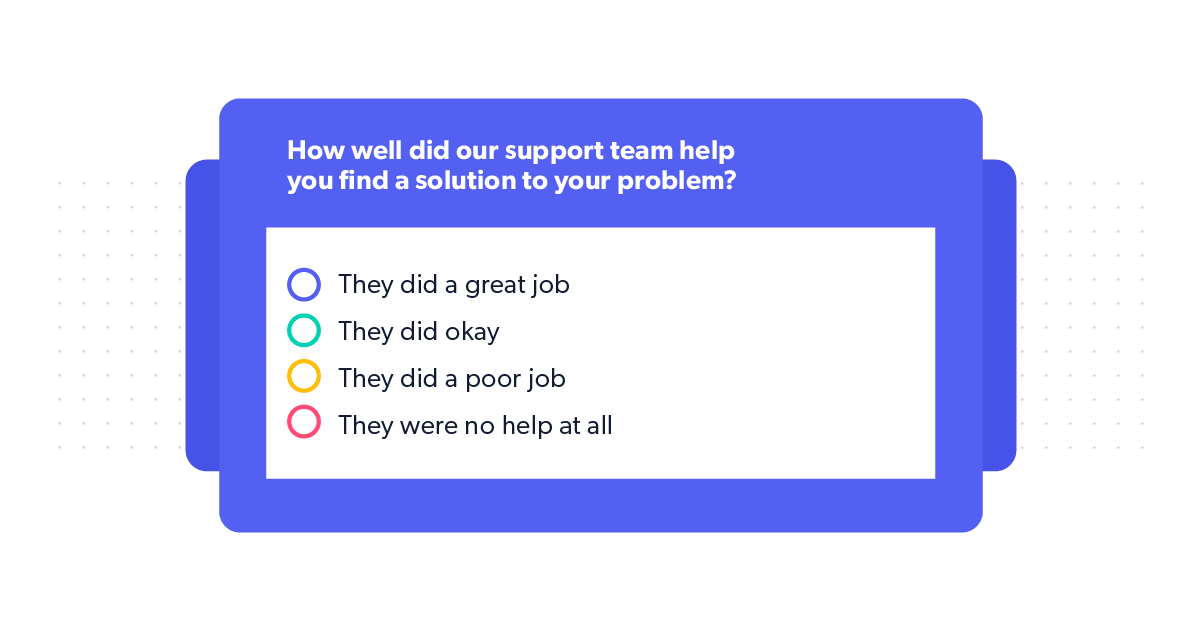
Things to keep in mind when creating customer satisfaction and product surveys
Selecting the best tools
There are a host of great customer feedback tools out there running the gamut in price and functionality. Free tools like Typeform and HotJar can help you get started.
When you’re ready to up your game, Bazaarvoice also offers multiple tools as well as opportunities to get feedback from our Influenster community.
A/B testing
As we mentioned earlier, it’s best to experiment with different question formats. Changing how you phrase a question can also elicit different responses, as will the length of your questionnaire.
But don’t experiment at random. Instead, run A/B tests, where you change one variable on the questionnaire and see if that affects the quality or quantity of your results.
Shorter is (usually) better
In your A/B tests, we wouldn’t be surprised if you find that shorter surveys receive more responses. That’s because attention spans are short and — real talk — no one really enjoys filling out lengthy questionnaires.
As part of your A/B tests, experiment with sending 1 long survey vs. 2 (or even 3) shorter surveys.
Only collect the data you need
Don’t ask unnecessary questions or questions that you already know the answer to. It just makes the survey longer (see above). Depending on the question, it can also distract and frustrate consumers.
In conclusion
Customer satisfaction and product survey questions give you the opportunity to learn valuable insights about shoppers’ needs, goals, and perceptions. They also help you uncover pain points in the shopping and purchasing experience.
With the right strategy in place, you can be confident you’re collecting the data you need to consistently deliver the highest level of customer satisfaction and service.
Then take this data and use it to implement a first-party data strategy.

